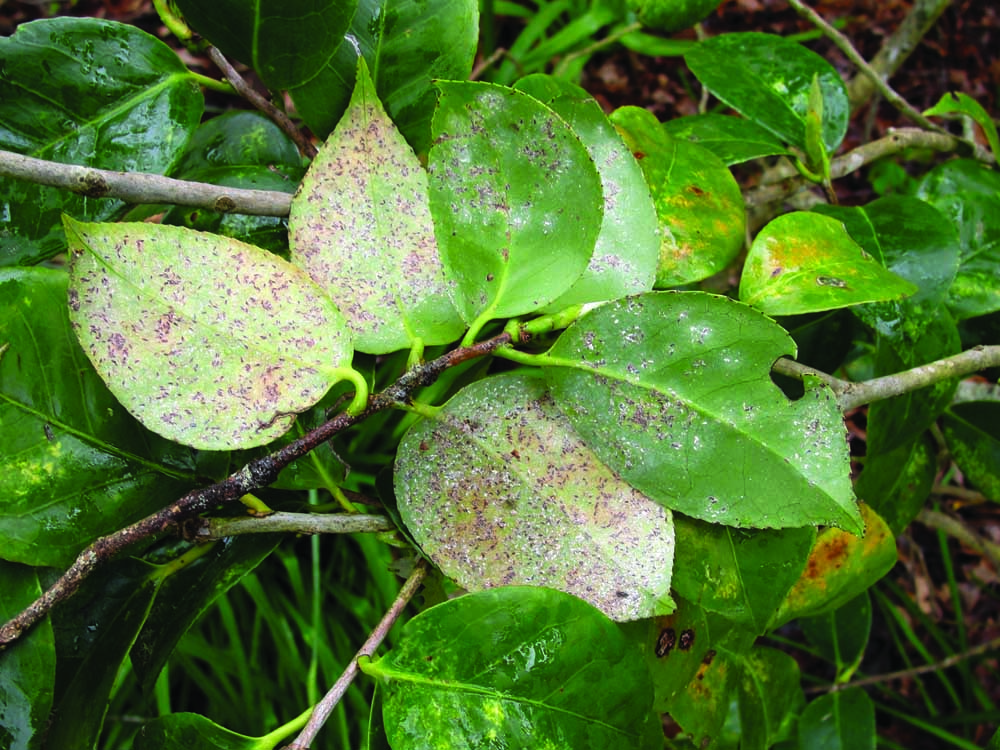Tea scale infests the underside of camellias
Published 4:47 pm Tuesday, March 24, 2020

- Tea scale insects beneath the foliage cause patchy yellowing on camellia leaves.
Camellias are a beautiful part of our East Texas landscapes during the winter and early spring. Unfortunately, if you grow camellias, you are most likely familiar with tea scale.
Tea scale is an insect that feeds and infests the underside of camellias (especially Camellia japonica) and Burford holly leaves. When scale numbers are high, the top portion of the leaves become mottled with patches of yellow and green. The scale insects are concealed underneath a cottony white material beneath the foliage. The actual insects are small and brownish gray and often appear to be white and brown flecks. Though they don’t kill the plants, they feed by sucking the sap and can cause unsightly damage if left untreated.
Trending
Tea scale gets its name from the tea that we drink, which is made from the related Camellia sinensis. Female scale insects are able to reproduce every one to two weeks, increasing the population exponentially. Newly hatched scale insects are called crawlers and are able to move about the plant to colonize new sections. Crawlers can move to new plants using the wind by flying a silk kite. Insecticides are much more effective when used to treat the crawlers, which typically emerge in the spring. Camellias and other tea scale infested plants should be treated with an oil spray when the temperatures are mild (not cold or hot).
Spray the entire plant, top to bottom, especially the underside of the leaves, with dormant oil, neem oil or horticultural oil. These are all very low in toxicity and do not leave behind any residue which harms beneficial insects. Contact insecticides can work but are much less effective than oil treatments or systemic insecticides. However, including a contact insecticide labeled for scale with your oil spray does make it more effective. Systemic insecticide products also work well at this stage and control crawlers as well as adult scale insects. Imidacloprid (Bayer Advanced Tree and Shrub Insect Control and other brands) is a systemic insecticide that is effective against tea scale. It is available in both granular and liquid forms. When a very heavy infestation is observed, use both horticultural oils and imidacloprid. A two-prong approach will provide the best results. Oil sprays can be used during the fall, winter and spring, but only use systemic insecticides when the plant finishes blooming in the spring so no pollinators will be affected.
Dead scale insects turn a darker shade of brown or black and slowly flake off the underside of the leaf. There are several generations of tea scale crawlers each year, so monitor your plants monthly to catch any new outbreaks. Catching the issue early is the best way to avoid heavy infestations. Heavily infested shrubs should be monitored and treated as needed, and may require several years of control. Increasing air circulation within the plant helps to open the insects up to natural predators such as lacewings, ladybugs and spiders.
Greg Grant is the Smith County horticulturist for the Texas A&M AgriLife Extension Service. He is author of “Texas Fruit and Vegetable Gardening,” “Heirloom Gardening in the South” and “The Rose Rustlers.” You can read his “Greg’s Ramblings” blog at arborgate.com and his “In Greg’s Garden” in each issue of Texas Gardener magazine (texasgardener.com). More research-based lawn and gardening information from the Texas A&M AgriLife Extension Service can be found at aggieturf.tamu.edu and aggie-horticulture.tamu.edu.






